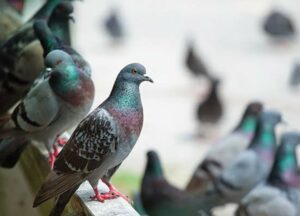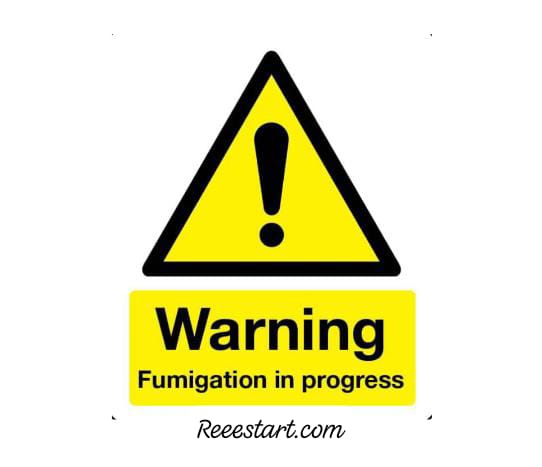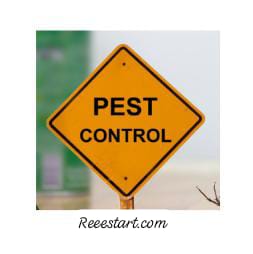In this article, we will discuss the reasons for the need to keep pigeons and wild birds away from our properties, the importance of prevention and control, and the reasons for their invasion of private and public buildings. Also,we will focus on The most effective feral pigeons control methods.
Feral pigeons control methods
When it comes to feral pigeons Control, lethal methods are often discouraged in favor of humane and long-term solutions. Here’s a breakdown of the most effective methods for controlling pigeon populations:
Food Source Reduction
This is the single most effective method. Eliminate easy access to food by securing garbage bins, not feeding pigeons in parks, and discouraging people from leaving out food scraps.
Exclusion
Block pigeons from nesting and roosting areas with netting, wire mesh, spikes, or other deterrents. Seal any gaps or holes in buildings they might use for nesting.

Non-lethal Deterrents
Non-lethal Deterrents include the following:
Visual Deterrents
Use scarecrow-like figures, reflective tape, or balloons with predator eyes to scare pigeons away. However, these may lose effectiveness over time as pigeons become accustomed to them.
Auditory Deterrents
Ultrasonic devices or recordings of predator calls can be used, but effectiveness varies and some people find them unpleasant.
Trapping and Relocation
Trapping and releasing are the most effective feral pigeons control, it can be used in conjunction with other methods. However, releasing pigeons back into the wild requires expertise to ensure their survival.
Birth Control
Pigeon Spikes with Nest Deterrents, These combine spikes with a special gel that disrupts nesting attempts.
OvoControl, This relatively new method involves coating pigeon eggs with a substance that prevents hatching. It requires a permit and professional application, but it’s a humane long-term solution
By focusing on habitat modification and humane deterrents, you can effectively control pigeon populations without harming the birds.

Why Should Pigeons and Birds be Controlled?
- By nature, pigeons prefer to live in high places, so when they move from the wild to urban areas, they choose tall buildings to live in.
- Searching for safe areas near stable food sources that allow them to survive and reproduce, once pigeons find these places and settle in them, they are quickly followed by large numbers, as pigeons tend to live in large groups.
The Health Reasons for Combatting Pigeons
Wild pigeons are a common type of birds that cause many health and material problems in all types of buildings in urban areas, While pigeons are often seen as just city birds, their droppings can pose some health risks. Here’s why controlling pigeon populations can be a public health concern:
- Pigeon droppings can harbor fungi and bacteria that can cause illnesses in humans. These illnesses, though uncommon, can be serious, especially for those with weakened immune systems. Some examples include:
- A fungal infection that can cause flu-like symptoms and respiratory problems.
- Cryptococcosis, Another fungal infection that can affect the lungs, nervous system, and skin.
- Psittacosis, A bacterial infection that can cause fever, pneumonia, and flu-like symptoms.
- Indirect Transmission, Dried droppings can turn into dust particles that carry these pathogens. Inhaling this dust can lead to infection. This is especially risky when cleaning up droppings in enclosed spaces.
- Risk Factors,While healthy people are generally at low risk, the young, elderly, and those with compromised immune systems are more susceptible to serious complications from pigeon-related diseases.
It’s important to note that with proper precautions, like wearing gloves and a mask while cleaning droppings, the risk of infection is quite low. However, controlling pigeon populations helps minimize the overall risk of exposure, especially in areas with high pigeon concentrations.
The Detriments of Pigeon Gatherings
Pigeon gatherings, beyond the health risks mentioned earlier, can cause a number of problems:
Mess and Property Damage, Pigeon droppings are acidic and can damage statues, vehicles, buildings, and awnings. They are also unsightly and unpleasant to walk through.
Noise Pollution, Large flocks of pigeons can be quite noisy, especially early in the morning. Their constant cooing can be disruptive to residents and businesses.
Public Health Nuisance, The sheer volume of droppings in areas with large pigeon populations can be overwhelming for sanitation crews. This can create unsanitary conditions and unpleasant odors.
Discourage Use of Public Spaces, Large flocks of pigeons can make parks, plazas, and other outdoor areas less inviting for people. The droppings, noise, and potential health concerns can deter people from enjoying these spaces.
Economic Impact, The detriments pigeons cause to property and public spaces can lead to economic costs for businesses and municipalities. Repairs, cleaning, and preventative measures all require resources.
In conclusion, understanding the reasons and potential harms of having pigeons and birds in public and private properties is vital for implementing effective combat strategies to preserve the environment and public health.




